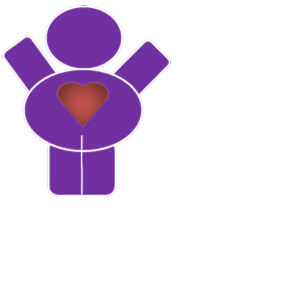Glossary
Anticoagulant. Blood Thinners. Medications which reduce or impair the ability of the blood to form clots. These medications are used to retard clot formation on artificial devices or in certain.
Aorta. Important artery that exits the left ventricle.
Arrhythmia. Any deviation from a normal rhythm is defined as an arrhythmia, where the heart is beating too fast, too slow, beating irregularly or a combination of these abnormal rhythms.
Artery. Any blood vessel that carries blood from the heart to the body. Contains oxygenated blood..
Atresia. The absence of a normal body passage or opening (orifice) from an organ or other part of the body.
Atrial Septal defect (ASD). It occurs when both atria are connected by a resizable window. Normally there should be no such communication except during fetal life.
Bladder catheter. Latex or silicone catheter with a balloon on the end that is filled with air or with a sterile liquid once placed in the bladder. It is used when you want a continuous drainage so we can make an accurate measurement of urine output.
Bradycardia. A slow heart rate. (Rates depend upon the child’s age.)
Cardiac catheterization. Procedure that involves puncturing an artery or vein, usually located in the groin, so that a small, long, flexible tube (catheter) can be guided into the heart and major vessels around the heart.
Cardiomegaly. Enlargement of the heart.
Cardiomyopathy. A disease of the heart muscle that causes it to lose its pumping strength.
Cardiopulmonary bypass. Technique used during cardiac surgery that uses a special machine that replaces the function of the heart and lungs during surgery.
Catheter. A narrow tube which can be passed inside blood vessels to the heart for diagnostic and treatment purposes.
Central venous catheter. Catheter inserted through the internal jugular, subclavian or basilic, with one end located generally in the superior vena cava or the right atrium. It is used for diagnostic or therapeutic interventions.
Coarctation of the aorta. Narrowing of the aorta that may not produce any symptoms. It also causes symptoms such as arterial insufficiency or hypertension.
Congenital. That which is formed or produced in utero and is born with it.
Corrective surgery. Any surgery can correct a heart defect. It is also known as definitive surgery.
Cyanosis. Bluish skin. It means that arterial blood contains less oxygen than it should have. Observed in heart and lung diseases.
Diastole. Period of the cardiac cycle during which the heart relaxes and fills with blood.
Diuretic. Medicine with the ability to increase urine production.
Ductus arteriosus. Tube that connects the aorta to the pulmonary artery and remains open during fetal life. Closes shortly after birth.
Echocardiography. Also known as cardiac ultrasound. Very high frequency sound waves are used to "see" the shape and function of the heart.
Electrocardiogram. Study of the heart's electrical activity.
Endocarditis. Infection of the lining that covers the inside of the heart. It affects the valves. Can be prevented.
Electrophysiological study. Form of cardiac catheterization to diagnose and treat cardiac arrhythmias.
Extrasystole. The heart rate is regular, ie, there is a constant time period between heartbeats. A premature beat is one that occurs earlier than expected. It may be atrial or ventricular.
Fallot (tetralogy of Fallot). The most common cyanotic congenital heart disease. It's called tetralogy because there are 4 abnormalities present: pulmonary stenosis, ventricular septal defect (VSD), right ventricular hypertrophy and overriding of the aorta.
Functional murmur. One who does not translate into any disease, typical of children.
Heart failure. It occurs when the heart is unable to send enough blood to the body and/or lungs.
Heart monitor. Electronic device that is used for continuous monitoring of cardiac function and provides an electrocardiograph.
Heart murmur. Abnormal sound heard during cardiac auscultation due to blood flow in the chambers or by the opening or closing valves.
Holter. Diagnostic test to record an electrocardiogram for 24 continuous hours or more.
Hypertension. Increased pressure in the arteries. There are two types. Hypertension (systemic circulation, the pressure of the body) is the most popular and common in older people. Pulmonary hypertension is an increase in pressure in the arteries and pulmonary vessels.
Hypoplasia. Means small because of lack of development, such as "hypoplastic left heart," "mitral hypoplasia."
Idiopathic. Name given to a disease when the cause is unknown.
Inotropic. Drugs that increase the force of contraction of the heart.
Left atrium. Heart chamber that receives blood from the lung veins. It connects with the left ventricle via the mitral valve.
Left ventricle. Heart chamber that pumps oxygenated blood to the aorta from where it goes to the rest of the body.
Myocardium. It is the part of the heart that consists of the cardiac muscle. It ss responsible for giving strength to the heart.
Myocarditis. Inflammation of the heart muscle caused by an infection (viral, bacterial or parasitic), a toxic agent, drugs, radiation, or autoimmune disease. It may not show symptoms or signs of heart failure.
Mitral. Valve that connects the left atrium to the left ventricle.
Nasogastric tube. Tube placed into the stomach through the nose usually to feed the baby and to administer medication.
Pacemaker. Electronic device used to electrically stimulate the heart. Can be internal or external (inside or outside the body).
Palliative surgery. Surgery that does not correct a heart defect but instead prevents the further complications it causes. Example: Banding (banding) pulmonary, Blalock-Taussig shunt and Glenn shunt.
Pericardium. One of the layers that surround the heart. When it becomes inflamed pericarditis occurs.
Pulmonary alveoli. The small, sac-like structural unit of the lung where oxygen is exchanged for carbon dioxide.
Pulmonary (artery). Artery through which blood reaches the lungs from the right ventricle.
Pulmonary (valve). It serves as a key step between the heart and pulmonary artery.
Prophylaxis. Activities to prevent infection.
Prosthesis. A device used to correct defects in the heart or blood vessels and can be artificial or biological.
Right atrium. Heart chamber that receives blood from the body’s veins. It connects with the right ventricle via the tricuspid valve.
Right ventricle. Heart chamber that pumps oxygenated blood to the lungs.
Stenosis. Means narrowing. The four heart valves normally open and then close. There is talk of stenosis when they don’t fully open causing obstruction to the blood flow.
Stress test. ECG recording of the child while making a physical effort on a stationary bike or treadmill. Required to be older than six years because we need the child's cooperation.
Syncope. Sudden decrease in blood pressure and/or heart rate. It often causes dizziness, paleness and even unconsciousness.
Systole. Moment or period of the cardiac cycle during which the heart contracts and pushes blood into the aorta and pulmonary arteries.
Stent. Metallic device that is implanted within a blood vessel during cardiac catheterization in order to keep it open.
Tachycardia. Increased heart rate (heart beating fast).
TGA. Congenital heart disease causing cyanosis. Requires surgical treatment.
Tricuspid (valve). Connects the right atrium to the right ventricle.
Valvular insufficiency. The four heart valves are normally open and then close. Valve failure occurs when they do not close completely, allowing blood to flow in the opposite direction (the valve has a leak).
Vein. Blood vessel that carries deoxygenated blood from the body to the heart (right atrium). The pulmonary veins carry oxygenated blood from the lungs to the heart (left atrium).
Ventricular Septal defect (VSD). It occurs when there is communication between the two ventricles. There should never be such communication.

